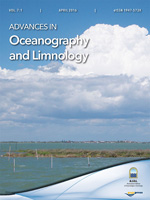Investigation of echo sounding parameters for the characterisation of bottom sediments in a sub-tropical reservoir

All claims expressed in this article are solely those of the authors and do not necessarily represent those of their affiliated organizations, or those of the publisher, the editors and the reviewers. Any product that may be evaluated in this article or claim that may be made by its manufacturer is not guaranteed or endorsed by the publisher.
Accepted: 17 June 2016
Authors
The increasing number of reservoirs around the world today reaches a surface area of around 500,000 km², equaling one third of that of non-artificial surface water bodies. By impounding rivers through the construction of dams, riverine systems and biochemical cycles are disrupted. Different types of transported materials are trapped behind the dams and form layers of sediment. A method to characterise the spatially extensive sediment volumes with an EA 400 echo sounder was tested in the Vossoroca reservoir in the southeast of Brazil, Paraná State. A number of core and grab samples was taken and analysed for a variety of chemical and physical parameters. These data served as ground truthing for the hydro-acoustic assessment of the sediment. Eight hydro-acoustic parameters were derived from the echo signals using the Sonar5-Pro software. The major objective of defining the optimal survey parameters for the echo sounder as well as determining the difference between core and grab samples was reached by correlating the various single parameters and identifying the best combinations. Density and grain size distribution represented the best detectable sediment features with r-values of 0.94 and 0.95. The lower 38 kHz frequency generally had a better performance than the 200 kHz frequency. Results show that core samples reached a significantly higher quality of correlation for sediment characterisation. Additionally, it is was found that shorter pulse lengths yield a better characterisation. The results underline the potential of single beam echo sounders for extensive sediment characterisation. This methodology may be used for future mass balance estimations of large reservoirs.







